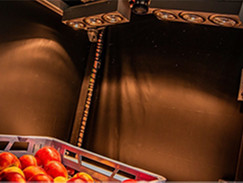
In a world where technology and agriculture are increasingly intertwined, there's a groundbreaking development that's set to change the way we perceive fruit. Researchers from Wageningen University & Research have recently developed a device, termed the all-in-one Spectral Cabinet, that uses infrared technology to determine the internal quality of fruit.
Imagine a device the size of a large cabinet. Inside this "cabinet" are two infrared cameras that scan fruit for various quality attributes such as sugar content, dry matter, and firmness. The most remarkable feature is that this assessment is done without physically touching the fruit, ensuring it remains untouched and undamaged.
While the use of infrared to measure fruit isn't entirely new - handheld scanners exist performing a similar function - the Spectral Cabinet offers a more large-scale and efficient approach. Infrared can penetrate 5 to 10 millimeters into a fruit's skin, revealing a wealth of information previously hidden from the naked eye.
A demonstration showcased the cameras moving across a box of apples for a few seconds. Almost instantly, a detailed overview appeared on a computer screen, displaying the condition of each individual fruit. Notably, there was a significant variation among the apples, emphasizing the need for thorough and comprehensive measurement to ensure accurate results.
The current iteration of the Spectral Cabinet is merely a demonstration model, but its potential for the future is boundless. For instance, by attaching a robotic arm to the system, we could automatically select apples or other fruits based on specific criteria, such as sweetness. This could revolutionize the way fruits are sorted and chosen, ensuring consistent quality for producers and consumers alike.
This advancement in agricultural technology underscores the importance of innovation in the food production sector. With tools like the Spectral Cabinet, we can not only gain a deeper understanding of our food's quality but also contribute to more efficient and sustainable production methods.
Source: ©Wageningen Universiteit & Research